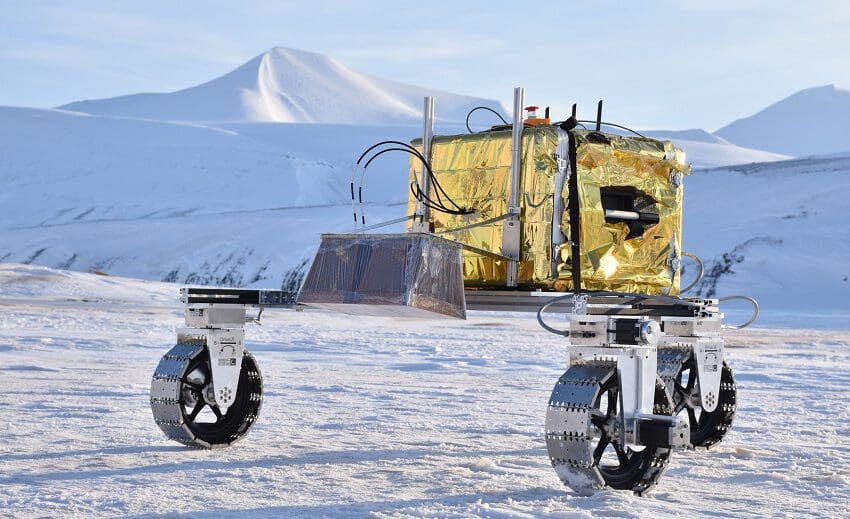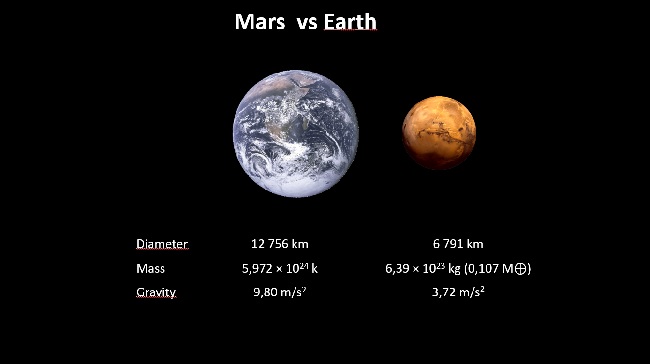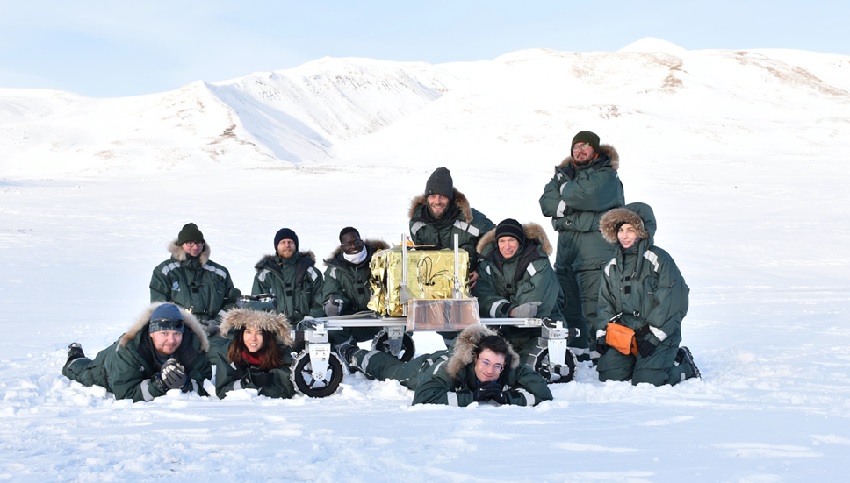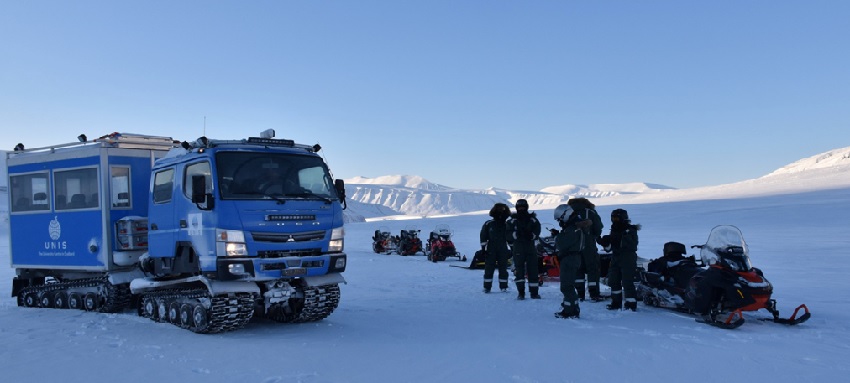Svalbard as testing ground

The rover mockup a copy of the WISDOM-antenna, ready to explore the Arctic landscape. Photo: Dirk Plettemeier
Top image: The rover mock-up and a copy of the WISDOM-antenna, ready to explore the Arctic landscape. Photo: Dirk Plettemeier
It’s cold, harsh, and hostile. The Svalbard glacial landscape is easily accessible, yet unfriendly. That’s why it is perfect testing ground for scientists who are interested to look for the presence of ice on Mars.
30 March 2022
Text: Maria Philippa Rossi
For two weeks, a team of researchers from Germany and France have been visiting UNIS to test their equipment for the ExoMars mission. Its launch was planned for September 2022, but the operation is suspended due to the war in Ukraine. Nevertheless, the researchers got valuable data and experience during their stay.
The ExoMars-mission, led by the European Space Agency, aims to look for past or present life on Mars, as well as the water conditions on the planet. ExoMars consists of a rover with nine different instruments. One instrument is the WISDOM-ground penetrating radar (GPR) that has been thoroughly tested in Svalbard.
The specially designed antenna of the WISDOM GPR helps to detect anomalies of potential scientific interest and hazards for the for the drill in the subsurface below the rover. This will be a great help for the scientists to decide where to collect samples using the drill equipment on the rover.
Professor Dirk Plettemeier from Technische Universität Dresden, explains:
– It is very important to test the antenna we designed for the radar under Mars-like conditions. We’ve brought two copies to Svalbard to test our ability to understand what we see under the surface. This way, we can be well prepared when we have collected Martian data.

Going deeper than ever before
In Svalbard, there are many areas that can be seen as Martian analogues. The researchers have been on polygonal terrains, on alluvial fans, on pingos and on glaciers, all to learn from the images and interpret the data collected.
– Glaciers might not be the best analogue for Mars, but it’s a radar friendly environment. We get good data from the radar penetrating deep into the sub-surface, Professor Alice Le Gall, from the University of Versailles-Saint Quentin in France, explains.
Previous Mars-expeditions have looked at the surface conditions and drilled a couple of centimetres into the ground. The ExoMars-expedition aims to drill as deep as two metres to collect samples.
– The surface of Mars is very hostile. It’s cold, you have strong radiation and weathering conditions. Therefore, we’ll be looking at the sub-surface, where we might find traces of life that’s been preserved. The radar will be of great help in this process. The antenna hovering over the soil surface helps us to make sure there are no obstacles in the sub-surface. It helps us to understand the geological context of the site we plan to sample, Le Gall says.

Impacted by the war
The ExoMars Rover was supposed to be launched by a Russian rocket. The descent module, the surface platform and two scientific instruments on the Rover are under Russian responsibility. Following Russia’s withdrawal of their personnel from Europe’s Spaceport in French Guiana, it’s impossible to go forward with the launch as planned without their Russian colleagues. Bringing NASA or another agency onboard again on the mission will take years of preparation and rescheduling.
– It is very frustrating for all of us and especially also for the principal investigator of the WISDOM instrument Valérie Ciarletti who was not able to come to Svalbard. The mission has already been postponed several times. I’ve worked with this for 12 years, and there’s only a window for launch every two years, Le Gall says.
WISDOM on ExoMars was supposed to be the first ground penetrating radar (GPR) on Mars. But, due to previous postponements, both NASA and the Chinese space administration have sent a rover with a GPR to Mars.
– So, we’ll be the third ground-penetrating rover on Mars. But, with the uncertainty going on we are looking into new mission options. It is likely that the WISDOM-instrument will be on the Moon prior to reaching Mars, Plettemeier says.
From Atacama to Svalbard
The scientists’ goal has been to get as much practice around the instrument as possible before sending it to Mars. For example, the project has been to the Atacama-desert in Chile, doing a simulation of operation-campaign remotely navigating the rover.

– Some people were in the Atacama-desert, others were in the operation center in the UK. We were pretending they were on Mars, receiving data every day, analyzing it, and then deciding what to do next, based on the information we got. It was to test our ability to make good decisions in a short time, Le Gall says.
Plettemeier concludes that the stay in Svalbard has been very fruitful, and due to the help from professors, technicians, and students like Esther Mas at UNIS, they’ve been able to gather data from the moment they arrived. He thanked the support of the arctic technology group under the direction of Professor Gijsbert D. Breedveld and highlights especially Associate Professor in Arctic Technology, Aleksey Shestov as an invaluable resource.
– We’ve been able to do measurements from the first day, and we’ve acquired good data that we can share with UNIS. As we assess the complicated situation around the launch, we can gather data and use it for Arctic studies. I think it can be the start of a long collaboration, Plettemeier says.
